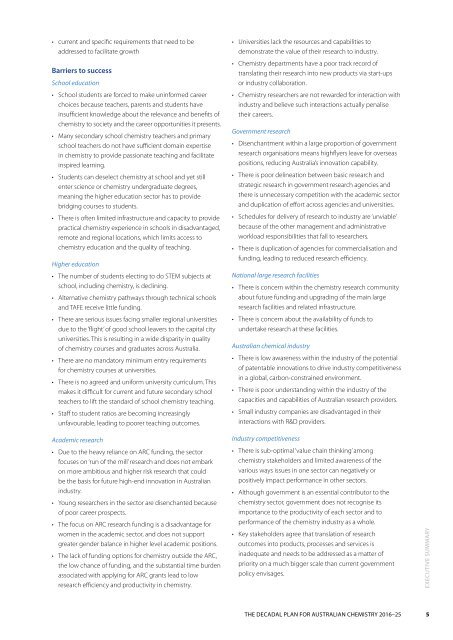Chemistry for a better life
1OiFLmD
1OiFLmD
You also want an ePaper? Increase the reach of your titles
YUMPU automatically turns print PDFs into web optimized ePapers that Google loves.
• current and specific requirements that need to be<br />
addressed to facilitate growth<br />
Barriers to success<br />
School education<br />
• School students are <strong>for</strong>ced to make unin<strong>for</strong>med career<br />
choices because teachers, parents and students have<br />
insufficient knowledge about the relevance and benefits of<br />
chemistry to society and the career opportunities it presents.<br />
• Many secondary school chemistry teachers and primary<br />
school teachers do not have sufficient domain expertise<br />
in chemistry to provide passionate teaching and facilitate<br />
inspired learning.<br />
• Students can deselect chemistry at school and yet still<br />
enter science or chemistry undergraduate degrees,<br />
meaning the higher education sector has to provide<br />
bridging courses to students.<br />
• There is often limited infrastructure and capacity to provide<br />
practical chemistry experience in schools in disadvantaged,<br />
remote and regional locations, which limits access to<br />
chemistry education and the quality of teaching.<br />
Higher education<br />
• The number of students electing to do STEM subjects at<br />
school, including chemistry, is declining.<br />
• Alternative chemistry pathways through technical schools<br />
and TAFE receive little funding.<br />
• There are serious issues facing smaller regional universities<br />
due to the ‘flight’ of good school leavers to the capital city<br />
universities. This is resulting in a wide disparity in quality<br />
of chemistry courses and graduates across Australia.<br />
• There are no mandatory minimum entry requirements<br />
<strong>for</strong> chemistry courses at universities.<br />
• There is no agreed and uni<strong>for</strong>m university curriculum. This<br />
makes it difficult <strong>for</strong> current and future secondary school<br />
teachers to lift the standard of school chemistry teaching.<br />
• Staff to student ratios are becoming increasingly<br />
unfavourable, leading to poorer teaching outcomes.<br />
• Universities lack the resources and capabilities to<br />
demonstrate the value of their research to industry.<br />
• <strong>Chemistry</strong> departments have a poor track record of<br />
translating their research into new products via start-ups<br />
or industry collaboration.<br />
• <strong>Chemistry</strong> researchers are not rewarded <strong>for</strong> interaction with<br />
industry and believe such interactions actually penalise<br />
their careers.<br />
Government research<br />
• Disenchantment within a large proportion of government<br />
research organisations means highflyers leave <strong>for</strong> overseas<br />
positions, reducing Australia’s innovation capability.<br />
• There is poor delineation between basic research and<br />
strategic research in government research agencies and<br />
there is unnecessary competition with the academic sector<br />
and duplication of ef<strong>for</strong>t across agencies and universities.<br />
• Schedules <strong>for</strong> delivery of research to industry are ‘unviable’<br />
because of the other management and administrative<br />
workload responsibilities that fall to researchers.<br />
• There is duplication of agencies <strong>for</strong> commercialisation and<br />
funding, leading to reduced research efficiency.<br />
National large research facilities<br />
• There is concern within the chemistry research community<br />
about future funding and upgrading of the main large<br />
research facilities and related infrastructure.<br />
• There is concern about the availability of funds to<br />
undertake research at these facilities.<br />
Australian chemical industry<br />
• There is low awareness within the industry of the potential<br />
of patentable innovations to drive industry competitiveness<br />
in a global, carbon-constrained environment.<br />
• There is poor understanding within the industry of the<br />
capacities and capabilities of Australian research providers.<br />
• Small industry companies are disadvantaged in their<br />
interactions with R&D providers.<br />
Academic research<br />
• Due to the heavy reliance on ARC funding, the sector<br />
focuses on ‘run of the mill’ research and does not embark<br />
on more ambitious and higher risk research that could<br />
be the basis <strong>for</strong> future high-end innovation in Australian<br />
industry.<br />
• Young researchers in the sector are disenchanted because<br />
of poor career prospects.<br />
• The focus on ARC research funding is a disadvantage <strong>for</strong><br />
women in the academic sector, and does not support<br />
greater gender balance in higher level academic positions.<br />
• The lack of funding options <strong>for</strong> chemistry outside the ARC,<br />
the low chance of funding, and the substantial time burden<br />
associated with applying <strong>for</strong> ARC grants lead to low<br />
research efficiency and productivity in chemistry.<br />
Industry competitiveness<br />
• There is sub-optimal ‘value chain thinking’ among<br />
chemistry stakeholders and limited awareness of the<br />
various ways issues in one sector can negatively or<br />
positively impact per<strong>for</strong>mance in other sectors.<br />
• Although government is an essential contributor to the<br />
chemistry sector, government does not recognise its<br />
importance to the productivity of each sector and to<br />
per<strong>for</strong>mance of the chemistry industry as a whole.<br />
• Key stakeholders agree that translation of research<br />
outcomes into products, processes and services is<br />
inadequate and needs to be addressed as a matter of<br />
priority on a much bigger scale than current government<br />
policy envisages.<br />
Executive summary<br />
THE DECADAL PLAN FOR AUSTRALIAN CHEMISTRY 2016–25 5


